Introducing… Stratos for SUSE CaaS Platform
A New View
Would you like to make your SUSE CaaS Platform clusters simpler and more intuitive to manage? Do you want to be able to manage multiple clusters from a single pane of glass, whether on premise or in public clouds? Would you like to be able to deploy applications to your clusters, no matter whether they are in a SUSE repository, other public repositories, or your organization’s private repositories?
SUSE CaaS Platform is introducing a tech preview of Stratos Console, a powerful browser-based graphical interface that delivers multi-cluster, multi-cloud management. You can assess the status and health of all of your managed clusters at a glance with multi-cluster overview dashboards, then drill down into any cluster for fine grained management of its workloads and resources.
A Closer Look
Stratos allows you to manage multiple endpoints (clusters). All you need do is give it some information about the addresses and credentials needed to access each cluster you want to manage. It then displays an overview page with the full set your of managed endpoints…
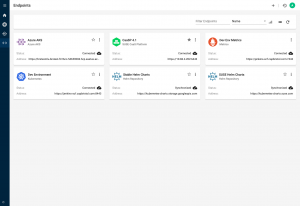
…and then allows you to access detailed information about each endpoint, including the operating system and version, Kubernetes version, and high-level health and resource information, as well as annotations and labels.
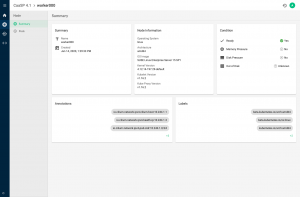
You can also see a list of the nodes in the cluster, including being informed about their health, resources, and workloads at a glance.
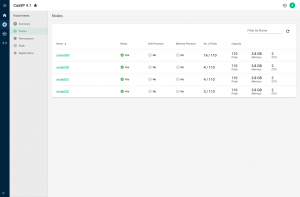
From there, you can drill down into a detailed view of each node.
You can also take a logical, application-oriented view of the cluster, starting with a list of application pods, and see where they are running and the resources they are using.
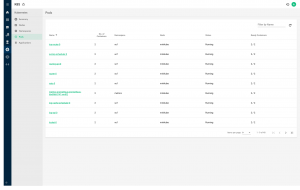
Just as with the node list, you can access a more detailed view of each pod, looking at information about each of the containers in it.
Stratos incorporates a metrics server which is a deployment of the de facto standard Prometheus package. It enables the console to display a rich set of performance metrics graphically. (We’ll be talking more about Prometheus with SUSE CaaS Platform, as well as a visualization tool called Grafana, in a near-future blog post.)
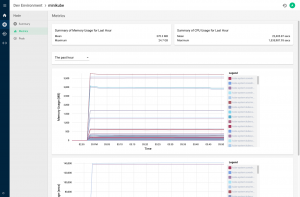
This is not an exhaustive view of the power of Stratos; there are more views that provide much more information to enhance and simplify SUSE CaaS Platform management.
Stratos also allows administrators to configure multiple Helm repositories from which to access applications – from SUSE, from other public sources, and private ones – to make deploying a wide range of applications and services easier.
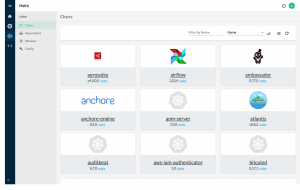
Stratos doesn’t just manage SUSE CaaS Platform clusters. It can manage any Kubernetes clusters – whether they are SUSE CaaS Platform, another vendor’s offering, a home-built version, or even the cloud Kubernetes offerings of AWS, Azure, and GCP. And it can also manage SUSE Cloud Application Platform deployment, for a rich 360 degree view of your cloud-native application delivery environments. (Just as it can manage any Kubernetes cluster, it can also manage any Cloud Foundry cluster, not just SUSE Cloud Application Platform.)
You’ll find information about deploying Stratos in the SUSE Cloud Application Platform documentation, for now. Between now and the official release of this new functionality later this year, it will appear in the SUSE CaaS Platform documentation as well.
How We Got Here
If you’re interested, here’s a bit of background. (If not, skip to the next headline to see what’s coming next in Stratos.)
The SUSE Application Delivery solution includes both SUSE CaaS Platform, our container orchestration and management system built on Kubernetes, and SUSE Cloud Application Platform, our cloud-native application development and deployment system build on Cloud Foundry.
SUSE has innovated in the Cloud Foundry ecosystem in two main ways. The first is the introduction of Stratos. The earlier versions of Stratos have become the leading user interface upstream for Cloud Foundry environments.
The second is bringing the efficient Cloud Foundry development and management model to the Kubernetes ecosystem. Through multiple projects, SUSE has been and is a leader in making Cloud Foundry a first-class citizen of the Kubernetes ecosystem.
Because our solution is modernized and Kubernetes-based, Stratos can enable views of the application delivery stack from the top of the stack (SUSE Cloud Application Platform) down through the platform that manages the containers and resources (SUSE CaaS Platform). If you use both, you see a rich set of views that unify the management experience. If you deploy only one – say, SUSE CaaS Platform with your own developer methodology and tools, or SUSE Cloud Application Platform running on AKS or EKS or GKE – you see only the views and options that are appropriate to that environment.
Coming Soon
In the time-honored “one more thing” tradition: we will soon make it possible for users to install the popular Kubernetes dashboard and then access it through Stratos, making it even more powerful. Watch this space for updates.
Related Articles
May 31st, 2022
No comments yet